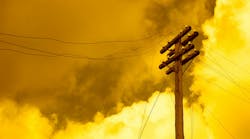When I started my utility arboriculture career in the early 1990s, many North American utilities had decentralized vegetation management programs run by operations managers, light-duty lineworkers or others without arboricultural training. The predominant perception was that it wasn’t “rocket science,” and anybody could do it without training. In those early days, I was informed many times that money spent on foresters or arborists was better spent “trimming trees.”
That perception was wrong then, and even more so now. Vegetation management is essential to utility operations. Failure in vegetation management has been an existential threat to utilities. Conflicts between trees and power lines have resulted in catastrophic fires, ruinous blackouts, public electric contacts, enforcement action from regulators and tarnished corporate reputations. Utilities have fallen into bankruptcy and chief executives have lost their jobs as a result. Now, vegetation management is often the largest utility operations and maintenance budgetary line item, and the contribution provided by utility arborists is indispensable.
Gaining Knowledge
The knowledge required for an effective vegetation management program is formidable. In addition to demanding command of dynamic natural systems, this work requires an understanding of program management, budgeting—often for tens of millions or hundreds of millions of dollars—remote sensing, communication, safety and the fundamentals of electrical systems, according to the Utility Arboriculture: The Utility Specialist Certification Study Guide published by the International Society of Arboriculture.
The criticality of VM is evident from the articles presented in the T&D World Vegetation Management Supplement, which is published in partnership with the Utility Arborist Association. This issue features articles about environmental stewardship, biodiversity, the cost effectiveness of integrated vegetation management (IVM) and chemically facilitated biological control. Alongside this content is collaboration with and leadership for utility tree workers to promote safety and professionalism. This supplement also includes articles featuring technological innovations from satellite imagery to artificial intelligence.
Investing in Technology
Technological developments are transforming vegetation management. A premise of IVM best practices is to base prescriptions on data, according to “Utilities & Vegetation Management in North America: Results from a 2019 Utility Forestry Census of Tree Activates & Operations,” a 2021 University of Wisconsin-Stevens Point publication. Vegetation managers can apply this principle by taking information supplied through remote sensing to deploy resources to areas of greatest risk. Moreover, technology can a help overcome the constraints imposed by insufficient human resource pressure. Technology drives efficiencies that can bridge the gap between need and resource limitations.
As essential as these technological advances are, they cannot replace competent field professionals. Practitioners on the ground are necessary to augment remote sensing, ensure quality control and deliver optimal programs. For example, remote sensing is unable determine tree flaws that can be identified through tree risk assessments.
Misuse of technology may drive vegetation management programs into a detrimental hotspot paradigm. The articles in this supplement by Jill Golden and Dr. Anand Persad provide insight into the importance of developing diverse, compatible plant communities through IVM. The method is not only cost effective, but it also has an added benefit for creating early successional habitat that benefits pollinators, ground nesting birds and other species for which habitat has been dwindling in recent decades due to development, agriculture and human preference for trees and forests. Technology by itself can’t deliver that result.
Focusing on Training
State-of-the-art IVM requires training. Credentials such certification and tree risk assessment from the International Society of Arboriculture are crucial. University of Wisconsin-Stevens Point, the Utility Vegetation Management Association, and the Utility Arborist Association have collaborated on a two-year Utility Vegetation Management Program. This program should be promoted by progressive utilities and contractors for their employees wishing to advance their vegetation management careers, according to Tomaszewski and Miller in the “2022 UVM Professional Development Program” article in the UAA Arborist Newsline.
It's clear that money spent on arborists is not better spent “trimming trees.” Professional vegetation management is central to enabling utilities to deliver safe, flawlessly reliable electricity while advancing environmental stewardship, all of which are core values of progressive utilities. T&D World recognizes the importance of vegetation management and has wisely selected articles for this supplement. They offer a blend of topics that provide information on the skills necessary to transform utility arboriculture to the benefit of arborists, utilities and the public.
Randall H. Miller ([email protected]) is the director of research and development for CNUC.


